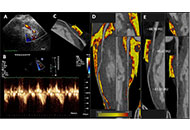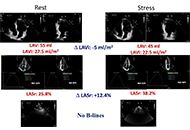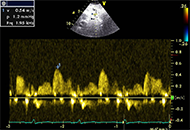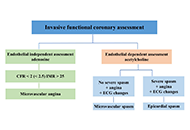Coronary vasospasm testing: escape from the cath lab!
Coronary vasospasm stands as a widely acknowledged and frequent culprit behind chest pain, acute coronary syndrome, and sudden cardiac death, yet it remains a challenging diagnosis. Current guidelin
[...] Read more.
Coronary vasospasm stands as a widely acknowledged and frequent culprit behind chest pain, acute coronary syndrome, and sudden cardiac death, yet it remains a challenging diagnosis. Current guidelines recommend invasive coronary function testing to assess pathophysiology and mechanisms and to define treatment. In reality, this protocol is rarely applied, because it necessitates extended occupation of the cath lab, repetitive administration of nephrotoxic iodine contrast agents, the need for repeated testing on both coronary arteries leading to considerable radiation exposure, and significant direct expenses. The promising perspective for vasospasm testing is a noninvasive approach with advanced echocardiographic techniques, such as transthoracic Doppler echocardiography, with more sensitive indicators of ischemia. Hyperventilation and exercise tests are used for vasospasm directed testing, with assessment of the new parameters: coronary flow velocities and reserve, allowing to see deeper into macro and microvascular pathophysiology. Association between coronary flow, global longitudinal strain and microvascular dysfunction (MVD) and impaired values at hyperemia was previously demonstrated. Reduction in coronary flow velocity (CFV) despite heightened myocardial oxygen consumption and double product during hyperventilation are indicative of coronary vasospasm. Normal coronary angiography finding in patients with documented evidence of ischemia should initiate additional diagnostic testing in order to increase the yield of specific diagnosis in patients with suspected vasospasm, which could help to personalize treatment and prognosis. In order to achieve this, non-invasive provocative stress echocardiography tests should be included in the diagnostic workup. This approach, characterized by its simplicity, feasibility, safety, and efficacy, is currently undergoing extensive testing on a large scale.
Ana Djordjevic Dikic ... Vojislav Giga
View:871
Download:26
Times Cited: 0
Coronary vasospasm stands as a widely acknowledged and frequent culprit behind chest pain, acute coronary syndrome, and sudden cardiac death, yet it remains a challenging diagnosis. Current guidelines recommend invasive coronary function testing to assess pathophysiology and mechanisms and to define treatment. In reality, this protocol is rarely applied, because it necessitates extended occupation of the cath lab, repetitive administration of nephrotoxic iodine contrast agents, the need for repeated testing on both coronary arteries leading to considerable radiation exposure, and significant direct expenses. The promising perspective for vasospasm testing is a noninvasive approach with advanced echocardiographic techniques, such as transthoracic Doppler echocardiography, with more sensitive indicators of ischemia. Hyperventilation and exercise tests are used for vasospasm directed testing, with assessment of the new parameters: coronary flow velocities and reserve, allowing to see deeper into macro and microvascular pathophysiology. Association between coronary flow, global longitudinal strain and microvascular dysfunction (MVD) and impaired values at hyperemia was previously demonstrated. Reduction in coronary flow velocity (CFV) despite heightened myocardial oxygen consumption and double product during hyperventilation are indicative of coronary vasospasm. Normal coronary angiography finding in patients with documented evidence of ischemia should initiate additional diagnostic testing in order to increase the yield of specific diagnosis in patients with suspected vasospasm, which could help to personalize treatment and prognosis. In order to achieve this, non-invasive provocative stress echocardiography tests should be included in the diagnostic workup. This approach, characterized by its simplicity, feasibility, safety, and efficacy, is currently undergoing extensive testing on a large scale.
 Coronary myocardial bridge imaging by stress-echocardiography and coronary adipose tissue attenuation on computed tomography angiographyOpen AccessPerspectiveMyocardial bridging is a congenital defect characterized by the course of a segment of the coronary arteries within the heart muscle most frequently affecting the left anterior descending coronary a [...] Read more.Domenico Tuttolomondo ... Nicola GaibazziPublished: February 29, 2024 Explor Cardiol. 2024;2:31–39
Coronary myocardial bridge imaging by stress-echocardiography and coronary adipose tissue attenuation on computed tomography angiographyOpen AccessPerspectiveMyocardial bridging is a congenital defect characterized by the course of a segment of the coronary arteries within the heart muscle most frequently affecting the left anterior descending coronary a [...] Read more.Domenico Tuttolomondo ... Nicola GaibazziPublished: February 29, 2024 Explor Cardiol. 2024;2:31–39 Left atrium stress echocardiography: correlation between left atrial volume, function, and B-lines at rest and during stressOpen AccessOriginal ArticleAim: Left atrial volume index (LAVI), left atrial reservoir function through left atrial reservoir strain (LASr), and B-lines in lung ultrasound serve as supplementary indicators of left ventricu [...] Read more.Costantina Prota ... Quirino CiampiPublished: February 26, 2024 Explor Cardiol. 2024;2:19–30
Left atrium stress echocardiography: correlation between left atrial volume, function, and B-lines at rest and during stressOpen AccessOriginal ArticleAim: Left atrial volume index (LAVI), left atrial reservoir function through left atrial reservoir strain (LASr), and B-lines in lung ultrasound serve as supplementary indicators of left ventricu [...] Read more.Costantina Prota ... Quirino CiampiPublished: February 26, 2024 Explor Cardiol. 2024;2:19–30 Feasibility of coronary flow velocity reserve during semi-supine exercise echocardiography: a single center study of 3,014 patientsOpen AccessOriginal ArticleAim: There is a lack of studies that analyzed factors influencing on feasibility of coronary flow velocity reserve (CFVR) during exercise stress echocardiography (SE). The aim of the study was to [...] Read more.Angela Zagatina ... Elena KalininaPublished: February 04, 2024 Explor Cardiol. 2024;2:9–18
Feasibility of coronary flow velocity reserve during semi-supine exercise echocardiography: a single center study of 3,014 patientsOpen AccessOriginal ArticleAim: There is a lack of studies that analyzed factors influencing on feasibility of coronary flow velocity reserve (CFVR) during exercise stress echocardiography (SE). The aim of the study was to [...] Read more.Angela Zagatina ... Elena KalininaPublished: February 04, 2024 Explor Cardiol. 2024;2:9–18 Coronary vasospasm testing: escape from the cath lab!Open AccessPerspectiveCoronary vasospasm stands as a widely acknowledged and frequent culprit behind chest pain, acute coronary syndrome, and sudden cardiac death, yet it remains a challenging diagnosis. Current guidelin [...] Read more.Ana Djordjevic Dikic ... Vojislav GigaPublished: February 04, 2024 Explor Cardiol. 2024;2:1–8
Coronary vasospasm testing: escape from the cath lab!Open AccessPerspectiveCoronary vasospasm stands as a widely acknowledged and frequent culprit behind chest pain, acute coronary syndrome, and sudden cardiac death, yet it remains a challenging diagnosis. Current guidelin [...] Read more.Ana Djordjevic Dikic ... Vojislav GigaPublished: February 04, 2024 Explor Cardiol. 2024;2:1–8